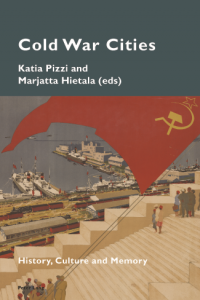Dr Katia Pizzi is Senior Lecturer in Italian Studies, and Director of the Centre for the Study of Cultural Memory, at the IMLR. Here, she talks about her new volume co-edited with Marjatta Hietala, ‘Cold War Cities: History, Culture and Memory’.
 The Cold War left indelible marks on many cities. My new co-edited volume, Cold War Cities: History, Culture and Memory (Oxford: Peter Lang, 2016), investigates global and local Cold War polarities with a view to countering received paradigms.
The Cold War left indelible marks on many cities. My new co-edited volume, Cold War Cities: History, Culture and Memory (Oxford: Peter Lang, 2016), investigates global and local Cold War polarities with a view to countering received paradigms.
City living and urban culture are relatively novel and advantageous stances from which to explore the Cold War and its legacy. Our aim is to integrate memory and history in order to shed light on the histories, memories, daily lives and forms of cultural exchange, consumption and production across and within cities during and after the Cold War. In particular, we focus on magazines, films, photographs, commercial fairs, choral societies, as well as memorial sites such as monuments, artefacts, cemeteries, ruined industrial sites and museums.
Several chapters address collective memory as a social framework through which individuals organise their history. Jan Assmann elaborated on the relationship between social and public memory, introducing the notion of ‘communicative memory’ to indicate memories orally mediated between living generations and ‘cultural memory’ to indicate monuments, museums, commemoration, rituals and a variety of cultural products. Assmann’s conclusion that cultural memory transcends human generations and is accessible across time is particularly pertinent to our aims. Mindful of this research, our book examines a large body of work, both public and private, material and immaterial, including commercial mobilisation of the past, tourism, commemoration and leisure time activities.
We examine twelve cities: Belgrade, Berlin, Bologna, Cairo, Helsinki, Izmir, Pripyat, Richland, Tampere, Trieste, Vienna and Vilinius. Our cities sit at the epicentre of the Cold War, contended in Second World War and post-Second World War geo-political negotiations (Vienna, Bologna, Berlin and Trieste). These cities are misaligned within their particular local and regional contexts, re-configured to suit a new state identity or subsequently pushed to the margins of history. As a result, their Cold War credentials were and, in many cases still are, skewed and ambiguous, yet absolutely key. These are nodes of ideological and geo-political confrontation. As such, they deserve reassessment. Other cities included here bear a complex and dynamic relation with Cold War history and memory, whether as a result of their technocratic stakes (Richland and Pripyat), shifting peripherality (Cairo, Izmir and Belgrade) and interfacing from within the Eastern (Vilnius) or Western (Helsinki, Tampere) Blocs. Several cities are explored through the lens of the Cold War for the first time here.
Without presuming to exhaust what remains a vast and complex field, Cold War Cities: History, Culture and Memory aims to reinvigorate Cold War historiography. Our examination of city life at this key juncture in world history and its construction and transmission in memory opens new perspectives.
Dr Katia Pizzi, Senior Lecturer in Italian Studies, and Director of the Centre for the Study of Cultural Memory, IMLR

